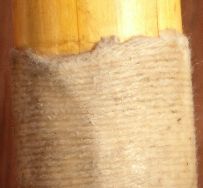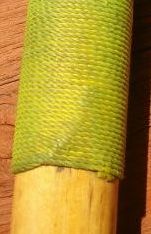


Whipping paddles!? This is not some form of ritualized
abuse but actually a method to protect your paddles. I am
not a paddling purest that says 'your paddle should never
touch the gunwale' and because I often use my wooden paddles in canoes
with aluminum gunwales I want to protect them from
abrasion. To protect the shaft of the paddle I use cotton, or
more recently nylon, cord and a simple whipping technique at the
point where the paddle might touch the gunwale. The technique is
basically the same as whipping the end of a rope to prevent it
from becoming frayed it involves no knots, tape, or
other stuff that is bumpy or sticky. Cord is not the only
material that can be used to protect your paddle. I have seen
everything from duck tape to leather but from an aesthetic standpoint
I think a whipped paddle is the most pleasing.

It takes less than an hour to cover about 30cm of a paddle shaft. The location of the whipping should cover the area where you are likely to come in contact with the canoe. When I use cotton cord I start with it wet so it stretches a bit and after it dries I impregnate it with wax. I usually use a ski waxing iron to melt the wax and warm the string. Nylon cord stretches quite a bit on its own and does not need to be treated. Nylon cord is harder on your hands than cotton cord.
Start near the blade and place several centimeters of the string end along the shaft going toward the grip. To start with I usually tape the end in place with edging tape. Wrap, or roll, the string over the end making sure that the cord is tight against the prior wrap. When you get near the loose end remove the tape and pull on it to make sure the string is tight. Continue to wrap until you are close to the length of whipping that you want. Place a loop of string several centimeters long along the shaft with the loop end where you will finish the whipping and the loose ends over the existing whipping. Again I usually tape the loose ends to the existing whipping to keep them in place. Continue to wrap over top of the loop until you have reached the length that you want. Place the end of the whipping string (plus extra) though the loop. Pull the end back under the whipping by pulling the loose ends of the loop. Pull until the loop comes out or there is enough pulled under to hold the whipping in place. Pulling the end of the whipping back under can be difficult if it is wrapped tightly - that is is a good thing. If it is easy to pull the loop under the whipping then it is not tight enough.
From: Merriam-Webster Dictionary
Main Entry: whip
3 a : to bind or wrap (as a rope or fishing rod) with cord for protection and strength b : to wind or wrap around something

Back to Home Page
Back to my Canoe Instruction WWW page
Paddle Manitoba Home Page
If you have any questions or comments please send me Email: burc...@cc.umanitoba.ca